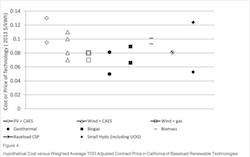A paper recently published in the March 2015 edition of Electricity Journal argues that the value of geothermal energy as well as other baseload renewables need to be better recognized as current options for electricity. Authors Ben Matek with the Geothermal Energy Association (GEA) and Karl Gawell, GEA executive director, write, “Misinformation about baseload renewables has distorted the discussion about the least-cost future renewable energy mix. There are renewable baseload power sources with generation profiles that can economically replace other retiring electricity sources megawatt for megawatt, thereby avoiding incurring additional costs from purchasing and then balancing renewable intermittent power sources with storage or new transmission.”
The article asserts that while there is no one-size-fits-all solution, the renewable energy sector will need to reevaluate the values of baseload renewables (traditionally, baseload power has been generated by nuclear, coal and natural gas) to address today’s power challenges and the dangers of climate change. These power options, argue the authors, provide numerous benefits that seem to have all but disappeared from the renewable energy conversation, including lower cost, better grid security, and a more optimal use of transmission infrastructure, they assert.
 Instead of just looking at short-term least-cost criteria, broader questions need to be asked when choosing between technologies, the authors state in the article. “To determine the best path forward, a number of system-wide issues need to be addressed. First, what combination of technologies really produces lowest system-wide costs when considering emission profile and reliability? And second, what mix of electricity sources will have the lowest cost considering both replacement costs and operation and maintenance costs over a period of several decades?”
Instead of just looking at short-term least-cost criteria, broader questions need to be asked when choosing between technologies, the authors state in the article. “To determine the best path forward, a number of system-wide issues need to be addressed. First, what combination of technologies really produces lowest system-wide costs when considering emission profile and reliability? And second, what mix of electricity sources will have the lowest cost considering both replacement costs and operation and maintenance costs over a period of several decades?”
The article concludes that when a path to go forward is chosen, renewables such as geothermal power, must be in the mix. In addition, the value of diversity should be recognized and integrated into the planning process.

